Social media platforms have become a crucial arena for businesses to reach and engage with their target audience. Among these platforms, Facebook stands tall, offering a variety of advertising options to help businesses maximize their online presence. As of January 2023, Facebook is the most popular social media platform worldwide with 2,958 million users. Two popular lead generation choices on Facebook are Facebook Ads and Boosted Posts.
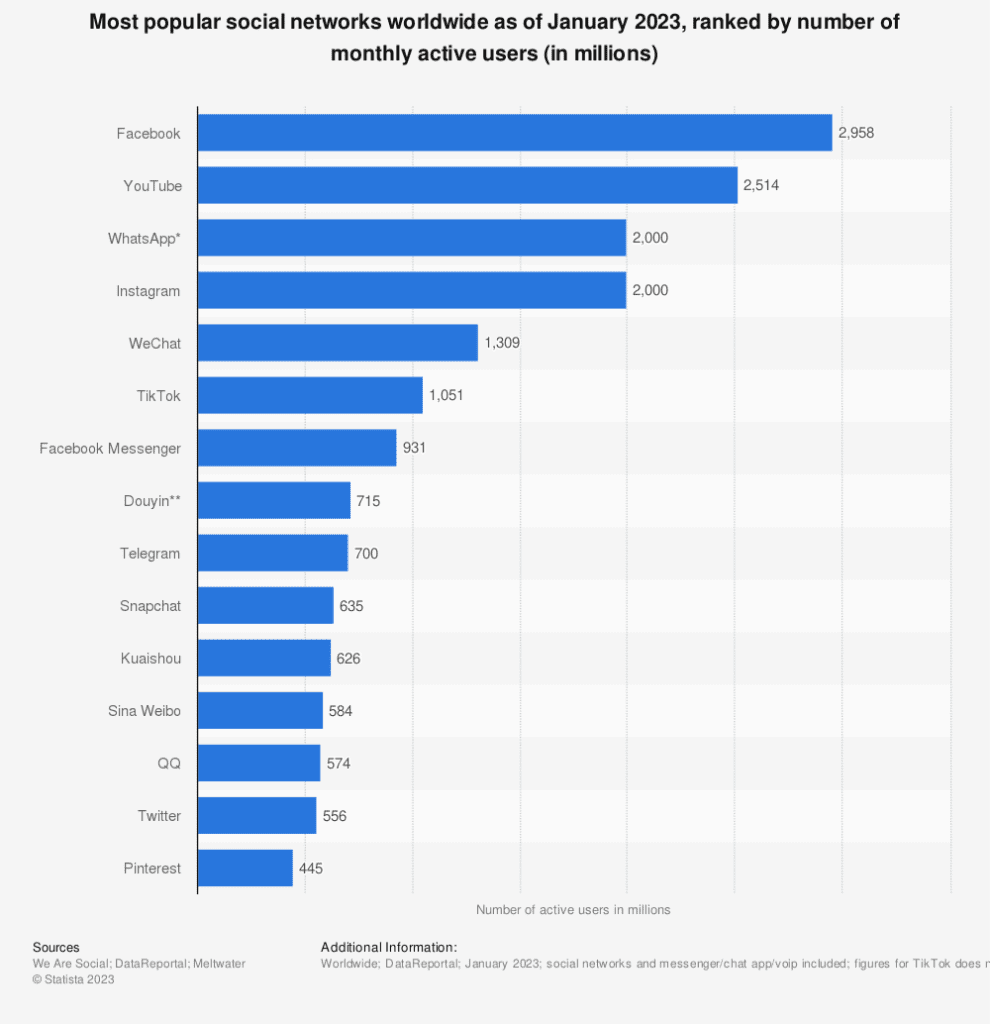
In this comprehensive guide, we will delve into the key differences between Facebook Ads and Boosted Posts, focusing on their effectiveness in generating leads. By understanding the nuances of these advertising tools, businesses can make informed decisions to optimize their lead generation strategies.
Understanding Facebook Ads
Facebook Ads is an advertising platform provided by Facebook, the world’s largest social media network. It enables businesses and advertisers to create and manage paid advertising campaigns on Facebook and its associated platforms, such as Instagram, Audience Network and Messenger.
Targeting options
The purpose of detailed targeting options in Facebook Ads is to help advertisers reach specific and relevant audiences based on various criteria. By using these options, advertisers can finely tune their ad campaigns, ensuring their messages are seen by the most relevant users, thereby maximizing the effectiveness of their advertising efforts.
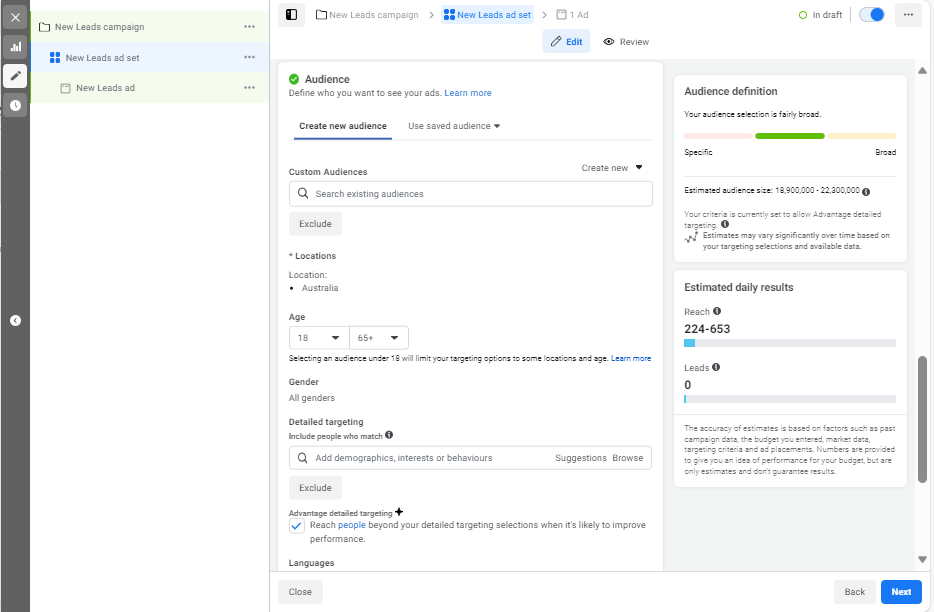
How to use detailed targeting options in Facebook Ads:
- Selecting the Audience: When creating a new ad campaign in Facebook Ads Manager, you’ll come across the “Audience” section. Here, you can either create a new audience or choose from saved ones.
- Location and Demographics: Start by setting the basic criteria such as location, age, gender, language, and other demographic details. This helps narrow down your audience based on where they are and who they are.
- Interests: Under the “Detailed Targeting” section, you can add specific interests, hobbies, pages liked, and activities relevant to your target audience. This allows you to target people who have expressed interest in related topics.
- Behaviors: Facebook offers behavioral targeting, allowing you to reach users based on their online activities, purchase behaviors, and device usage patterns.
- Connections: You can also target or exclude people connected to your Facebook Page, app, or events. For instance, you can show your ads to friends of people who have already liked your Page.
- Custom Audiences: Using this feature, you can target people who are already in your business’s database, such as existing customers or newsletter subscribers, by uploading their contact information to Facebook.

- Lookalike Audiences: Facebook enables you to create lookalike audiences based on your existing custom audiences. It identifies users with similar characteristics to your current customers, allowing you to expand your reach to potential new leads.
- Narrowing or Broadening the Audience: As you add targeting options, Facebook will show the estimated audience size. You can adjust the settings to narrow down or broaden your audience until you find the right balance.
- Saving and Reusing Audiences: Once you’ve defined your target audience, you can save it for future use. This is beneficial for recurring campaigns or when you have multiple segments you want to target.
- Testing and Optimization: It’s essential to test different targeting options to see which ones perform best for your objectives. Regularly review and optimize your audience settings to improve ad performance.
In summary, detailed targeting options in Facebook Ads allow advertisers to precisely define their target audience based on location, demographics, interests, behaviors, connections, custom audiences, and lookalike audiences. By utilizing these options effectively, advertisers can increase the relevance of their ads, boost engagement, and drive better results for their lead generation and marketing efforts.
Facebook Ad formats
Here are the different ad formats in Facebook Ads:
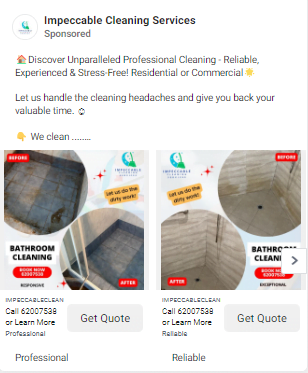
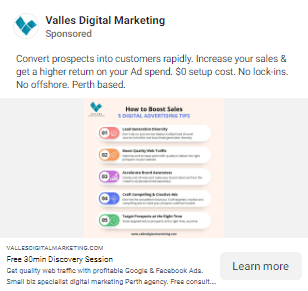
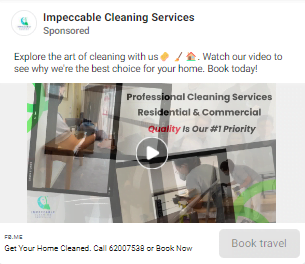
- Carousel Ads:
- What Are They: Carousel ads are interactive ad formats that allow advertisers to showcase multiple images or videos within a single ad unit. Users can swipe or click through the carousel to view different content pieces.
- Use Cases: Carousel ads are versatile and can be used for various purposes, including product showcases, storytelling, step-by-step guides, and highlighting multiple features or benefits of a product or service.
- Benefits: Carousel ads can capture the audience’s attention with engaging visuals and can convey a more comprehensive message than a single image or video. They are excellent for driving traffic to specific website pages or promoting a range of products.
- Single Image Ads:
- What Are They: Single image ads are the most straightforward ad format in Facebook Ads. They consist of a single static image along with ad copy and a call-to-action button.
- Use Cases: Single image ads work well for businesses with a clear, concise message or a visually striking product or service that can be showcased in a single image. They’re suitable for various campaign objectives, from brand awareness to lead generation.
- Benefits: These ads are quick to create, load fast, and can be effective when designed with compelling visuals and persuasive ad copy. They are a cost-effective choice for many businesses.
- Video Ads:
- What Are They: Video ads are dynamic ad formats that feature a video as the primary content. They can be in-feed videos or in-stream videos (playing before, during, or after other video content).
- Use Cases: Video ads are highly engaging and are excellent for storytelling, demonstrating products in action, sharing customer testimonials, and building brand awareness. They can also be used for lead generation by directing viewers to a landing page.
- Benefits: Video ads have the potential to capture the audience’s attention and convey complex messages effectively. They often have higher engagement rates and can be optimized for various campaign objectives, including views, clicks, or conversions.
- Collection Ads:
- What Are They: Collection ads are a unique ad format designed primarily for mobile devices. They combine a cover image or video with a collection of product images below it. When users tap the ad, they are taken to an immersive, fast-loading, and full-screen shopping experience.
- Use Cases: Collection ads are ideal for e-commerce businesses looking to showcase a range of products in a visually appealing format. They’re great for driving traffic to product catalog pages and encouraging immediate purchases.
- Benefits: Collection ads offer a seamless shopping experience within the Facebook platform, reducing friction for users to explore and purchase products. They can lead to higher conversion rates for e-commerce businesses.
Choosing the right ad format depends on your campaign objectives, target audience, and the story you want to convey. Facebook offers these various ad formats to provide flexibility and creativity in your advertising strategy, allowing you to select the one that best aligns with your goals and content.
Facebook Ads Placement options
- Facebook news feed
- Explanation: The Facebook News Feed is one of the most prominent and commonly used ad placements on the platform. It’s the constantly updating stream of stories in the middle of the Facebook homepage where users see posts from their friends, pages they follow, and sponsored content.
- Use Cases: Facebook News Feed ads are versatile and can be used for a wide range of campaign objectives, including brand awareness, website traffic, lead generation, conversions, and more. They allow advertisers to reach a broad and engaged audience.
- Benefits: News Feed ads blend seamlessly with organic content, making them less disruptive for users. They offer a variety of ad formats, including image ads, video ads, carousel ads, and more, allowing advertisers to choose the most suitable format for their goals.
- Instagram
- Explanation: Instagram is a popular social media platform owned by Facebook. Advertisers can place ads on Instagram to reach its user base. Instagram ads can appear in users’ feeds, stories, and the Explore tab.
- Use Cases: Instagram is known for its visual appeal, making it a great platform for businesses with visually striking products or services. It’s effective for brand awareness, product promotion, and driving engagement.
- Benefits: Instagram offers a highly visual and immersive ad experience. It has a younger and engaged user demographic, making it a valuable platform for businesses targeting millennials and Gen Z. Advertisers can use various ad formats like image ads, video ads, carousel ads, and story ads to capture users’ attention.
- Audience Network
- Explanation: The Audience Network is a collection of mobile apps and websites outside of Facebook that have partnered with Facebook to display ads. When advertisers choose to place their ads in the Audience Network, they can reach users while they are using other apps or browsing the web on mobile devices.
- Use Cases: The Audience Network is suitable for advertisers looking to extend their reach beyond the Facebook platform. It’s especially useful for driving app installs, generating leads, and increasing website traffic.
- Benefits: The Audience Network provides advertisers with access to a vast network of apps and websites, allowing them to reach users across different contexts. It can be cost-effective, and it offers various ad formats, including native ads, banner ads, interstitials, and rewarded videos.
Each of these placements in Facebook Ads offers unique advantages and can be tailored to specific campaign objectives and target audiences. The choice of placement should align with your advertising goals and the nature of your content or products. Effective ad placement is crucial for maximizing the performance and ROI of your Facebook advertising campaigns.
Optimization and bidding strategies
- Cost per Click (CPC):
- Explanation: Cost per Click (CPC) is a common pricing model in online advertising, including Facebook Ads. It represents the amount an advertiser pays each time a user clicks on their ad. Advertisers set a maximum bid for each click, and the actual CPC may be lower than the bid, depending on competition and ad quality.
- Use Cases: CPC is often used for campaigns with specific goals, such as driving traffic to a website, generating leads, or encouraging app installations. Advertisers are charged only when users take the desired action of clicking the ad.
- Benefits: CPC provides a straightforward way to measure the cost-effectiveness of your ad campaigns. It allows advertisers to control their spending by setting a budget and bid amount, ensuring they pay for actual user engagement.
- Cost per Mille (CPM):
- Explanation: Cost per Mille (CPM) is another pricing model in online advertising. It represents the cost advertisers pay for every 1,000 ad impressions or views, regardless of whether users interact with the ad. CPM is commonly used for brand awareness and reach campaigns.
- Use Cases: CPM is ideal for campaigns focused on building brand recognition and increasing the visibility of ads to a broad audience. Advertisers are charged based on the number of times their ad is displayed, not on user interactions.
- Benefits: CPM can be cost-effective for campaigns aiming to maximize exposure. It’s suitable for businesses that want to create awareness but don’t necessarily require immediate user actions. Advertisers can reach a large audience without worrying about click-through rates.
- Conversion Optimization:
- Explanation: Conversion optimization is a campaign objective and optimization method in Facebook Ads that focuses on driving specific actions, or conversions, from users. These actions can include website purchases, lead form submissions, app installs, and more. Facebook’s algorithm works to show ads to users most likely to complete the desired action.
- Use Cases: Conversion optimization is ideal when the primary goal is to encourage users to take a specific action, such as making a purchase or signing up for a newsletter. It’s effective for maximizing the return on ad spend (ROAS) and increasing the efficiency of ad campaigns.
- Benefits: Conversion optimization leverages Facebook’s machine learning algorithms to target users who are more likely to convert, resulting in improved ad performance. It also allows for more precise tracking and measurement of conversion events, helping advertisers understand the impact of their campaigns.
In summary, these terms in Facebook Ads represent different aspects of advertising strategy:
- CPC focuses on the cost of user engagement, with advertisers paying for each click on their ad.
- CPM deals with the cost of ad impressions, where advertisers pay for every 1,000 times their ad is displayed.
- Conversion optimization is a campaign objective that aims to drive specific user actions, leveraging Facebook’s algorithms to target the right audience for these actions.
Unpacking Boosted Posts
Boosted Posts on Facebook are a form of paid advertising that allows you to promote your existing organic (unpaid) Facebook posts to a larger and more targeted audience. Essentially, when you boost a post, you allocate a budget to have it shown to a wider group of Facebook users beyond your usual followers. This feature is designed to help you increase the visibility and engagement of specific posts, such as status updates, photos, videos, or links, by putting them in front of more people.
Boosted posts defined
Boosted posts can enhance engagement and lead generation by leveraging two key elements: enhanced visibility and increased reach. Let’s explore how each of these aspects contributes to achieving these goals:
- Enhanced Visibility:
- Capturing Attention: Boosted posts, due to their increased visibility, are more likely to capture the attention of Facebook users as they scroll through their feeds. When your content appears prominently, users are more likely to stop and engage with it.
- Brand Exposure: Enhanced visibility ensures that your content is seen by a broader audience, including users who may not follow your page. This is crucial for brand exposure and getting your message in front of potential customers who might not have discovered your brand otherwise.
- Content Highlight: By boosting posts, you can draw attention to specific content that you believe is highly valuable or relevant to your audience. This can be content designed to drive engagement, such as polls, contests, or interactive posts.
- Storytelling: Enhanced visibility allows you to tell your brand’s story effectively. Whether it’s sharing success stories, customer testimonials, or behind-the-scenes glimpses, boosted posts can engage users emotionally and foster a sense of connection.
- Increased Reach:
- Broader Audience: Boosted posts expand your content’s reach beyond your existing followers. This means your message can reach users who may not be familiar with your brand but fall within your defined target audience based on demographics, interests, and behaviors.
- Lead Generation: For lead generation campaigns, increased reach is crucial. The more people you can expose to your lead generation forms or landing pages, the higher the likelihood of capturing leads. A larger audience means more potential leads.
- Engagement Potential: A larger reach often translates to increased engagement opportunities. More people liking, sharing, and commenting on your boosted post can create a viral effect, further increasing your reach and brand exposure.
- Remarketing Possibilities: When you boost posts to a wider audience, you can later use retargeting strategies to reach those who engaged with your content. This is valuable for nurturing leads who have already shown interest in your brand.
Boosted posts vs. organic posts
Boosted posts and organic posts on Facebook differ primarily in terms of their reach and visibility, as well as the strategy behind them:
- Reach and Visibility:
- Organic Posts: Organic posts are the regular, unpaid posts that you create and share on your Facebook Page. They are shown to your existing followers and may appear on their News Feeds if the Facebook algorithm determines that the content is relevant to them. The reach of organic posts is limited to your Page’s followers and depends on factors like engagement and the algorithm’s assessment of the post’s quality.
- Boosted Posts: Boosted posts are organic posts that you pay to promote to a larger and more targeted audience. By boosting a post, you can expand its reach beyond your existing followers and have it displayed to users who may not follow your Page but match the demographics and interests you specify. Boosted posts are labeled as “Sponsored” and are identified as paid content.
- Audience Targeting:
- Organic Posts: The reach of organic posts is largely determined by the algorithm and the engagement of your existing followers. You have limited control over who sees your organic posts beyond your Page’s followers.
- Boosted Posts: When you boost a post, you have greater control over who sees it. You can define your target audience based on demographics, interests, behaviors, and more. This allows you to reach a more specific and relevant group of users.
- Purpose and Strategy:
- Organic Posts: Organic posts are typically used for sharing updates, engaging with existing followers, and maintaining an active online presence. They are valuable for building and nurturing relationships with your current audience.
- Boosted Posts: Boosted posts are strategically used for specific marketing goals, such as increasing brand visibility, promoting products or services, driving website traffic, or generating leads. They are a form of paid advertising intended to achieve specific objectives.
- Cost:
- Organic Posts: Posting organically is free. You don’t pay to share content with your existing followers.
- Boosted Posts: Boosting a post incurs a cost based on your budget and the duration of the boost. You pay to extend the reach of the post to a broader audience.
- Measurement and Insights:
- Organic Posts: Insights for organic posts provide data on engagement, likes, comments, shares, and other interactions. You can assess the performance of your posts but with limited reach outside your existing audience.
- Boosted Posts: Insights for boosted posts provide more extensive data, including detailed information about the reach, engagement, and click-through rates among the paid audience. This data helps you evaluate the effectiveness of your paid promotion.
In summary, the primary difference between boosted posts and organic posts on Facebook is that boosted posts are paid promotions of your organic content with the goal of expanding reach and achieving specific marketing objectives. Organic posts are unpaid and are primarily seen by your existing followers. Both have their place in a Facebook marketing strategy, with organic posts serving as a foundation for audience engagement, and boosted posts used strategically to reach a wider and more targeted audience.
Advantages and limitations of boosted posts
- Simplicity and Ease of Use:
- Advantage: One of the primary benefits of boosted posts is their simplicity and user-friendliness. Boosting a post is straightforward and doesn’t require advanced advertising skills. You can create and launch a boosted post in just a few clicks, making it accessible to businesses of all sizes.
- Explanation: Boosted posts are designed for users who want to quickly promote their content without delving into the complexities of Facebook Ads Manager. This simplicity is especially advantageous for small businesses or individuals who may not have dedicated marketing teams.
- Limitations of Boosted Posts:
- Limitation: Boosted posts offer limited customization compared to full-fledged Facebook Ads. You have fewer options when it comes to ad format, placement, and targeting compared to what Facebook Ads Manager provides.
- Explanation: Boosted posts are best suited for straightforward promotion to a broad audience. If you have specific campaign objectives or require advanced targeting options, such as using custom audiences or lookalike audiences, you may find boosted posts too restrictive. Facebook Ads Manager offers more control over campaign customization.
- Lack of Detailed Analytics:
- Limitation: Boosted posts provide basic engagement metrics, such as likes, comments, shares, and the number of people reached. However, they lack the in-depth analytics available through Facebook Ads Manager, including conversion tracking and detailed audience insights.
- Explanation: While boosted posts offer some performance data, the absence of detailed analytics can make it challenging to assess the full impact of your advertising efforts. For businesses seeking precise data on ad performance and conversion tracking, using Facebook Ads Manager may be a more suitable option.
Boosted posts are advantageous for their simplicity and accessibility, making them a quick and easy way to promote content. However, they have limitations in terms of customization and in-depth analytics, making them less suitable for advanced marketing campaigns. Choosing between boosted posts and traditional Facebook Ads depends on your specific campaign goals and the level of control and insights you require.
Lead Generation Comparison
From a lead generation perspective, there are notable differences between Facebook Ads and Boosted Posts. Here are more detailed explanations of the lead generation comparison between Facebook Ads and Boosted Posts in terms of reach and visibility, conversion and engagement, cost-effectiveness, and analytics and tracking:
- Reach and Visibility:
- Facebook Ads (Advantage: Extensive targeting capabilities): Facebook Ads offer extensive targeting options, allowing advertisers to reach highly specific audiences based on demographics, interests, behaviors, and more. This extensive targeting capability ensures that your ads are shown to the most relevant users, increasing the likelihood of lead generation. You can also utilize features like lookalike audiences to expand your reach to users similar to your existing customers.
- Boosted Posts (Limitation: Limited targeting options): Boosted Posts have more limited targeting options compared to Facebook Ads. While you can specify demographics and interests, the level of granularity is reduced. Boosted Posts are designed for simplicity, making them suitable for reaching a broad audience but less effective for precise audience segmentation.
- Conversion and Engagement:
- Facebook Ads (Advantage: Customizable landing pages and lead forms): Facebook Ads provide the flexibility to create customized landing pages and lead generation forms. This allows you to design a seamless user journey from ad click to lead capture. You can optimize the landing page for conversions, A/B test different elements, and track user interactions with precision.
- Boosted Posts (Advantage: Simplified engagement with existing audience): Boosted Posts excel at simplifying engagement with your existing audience. They are valuable for encouraging engagement, such as likes, comments, and shares, among your current followers. While they can generate leads from your existing audience, their simplicity may not provide as tailored a conversion path as Facebook Ads.
- Cost-effectiveness:
- Facebook Ads (Advantage: Precise budget allocation and bidding strategies): Facebook Ads allow advertisers to allocate their budget precisely and choose from various bidding strategies, such as CPC (Cost Per Click) or CPM (Cost Per Mille). This flexibility enables efficient spending and the ability to optimize campaigns for lead generation.
- Boosted Posts (Advantage: Lower cost, but potentially less targeted reach): Boosted Posts often have a lower cost compared to Facebook Ads. However, this cost advantage may come at the expense of targeting precision. While they can be cost-effective for reaching your existing audience, they may not deliver the same level of efficiency as Facebook Ads in reaching new leads.
- Analytics and Tracking:
- Facebook Ads (Advantage: Comprehensive reporting and conversion tracking): Facebook Ads provide advertisers with comprehensive reporting and conversion tracking capabilities. You can track the entire customer journey, from ad engagement to lead generation and beyond. This data-rich environment allows for in-depth analysis and optimization of campaigns.
- Boosted Posts (Limitation: Basic engagement metrics): Boosted Posts offer basic engagement metrics, such as likes, comments, shares, and the number of people reached. While these metrics provide insights into the engagement with your content, they lack the comprehensive conversion tracking and audience insights available through Facebook Ads.
In conclusion, the choice between Facebook Ads and Boosted Posts for lead generation depends on your specific campaign goals and resources. Facebook Ads offer more advanced targeting, customization, and tracking capabilities, making them ideal for precision lead generation campaigns. On the other hand, Boosted Posts are simpler and cost-effective for engaging your existing audience but may not provide the same level of targeting and tracking for acquiring new leads.
Best Practices and Recommendations
Identifying campaign objectives
- Brand Awareness:
- For brand awareness campaigns, use both Facebook Ads and Boosted Posts to create a consistent and engaging brand narrative. Highlight your brand’s unique selling points and values in a visually appealing way.
- Consider using Facebook Ads to reach a broader audience with a compelling video or image ad that tells your brand’s story. Use Boosted Posts to reinforce these messages among your existing followers and encourage them to share your content.
- Lead Generation:
- Use Facebook Ads with conversion optimization objectives to drive traffic to dedicated landing pages where users can submit their contact information. Ensure your lead forms are concise and offer value to users.
- Leverage Boosted Posts to promote lead magnets like ebooks, webinars, or downloadable resources to your existing audience. This helps nurture leads from your current followers.
- Conversion Optimization:
- Facebook Ads are ideal for conversion optimization campaigns. Create targeted ads that drive users to take specific actions, such as making a purchase or signing up for a service.
- For Boosted Posts, consider boosting content related to successful conversions to reinforce trust and credibility among your audience.
Leveraging Facebook Ads
- Conducting Thorough Audience Research:
- Use Facebook’s Audience Insights and other analytics tools to understand your target audience’s demographics, interests, and behaviors. Create highly specific audience segments to maximize ad relevance.
- Continuously refine your audience targeting based on performance data. Experiment with different audience segments to discover which ones yield the best results for your campaign objectives.
- A/B Testing Creatives and Ad Formats:
- Run A/B tests with different ad creatives, headlines, and ad formats to identify what resonates most with your audience. Test variables such as video vs. image ads, carousel ads vs. single image ads, and ad copy variations.
- Analyze the results of A/B tests and allocate budget to the highest-performing creatives and formats to optimize your ad spend.
- Regular Performance Monitoring and Optimization:
- Monitor your Facebook Ads campaigns daily or weekly to identify trends and anomalies in performance metrics. Adjust your bids, budgets, and targeting parameters as needed to improve ROI.
- Utilize the Facebook Pixel for conversion tracking and retargeting. Create custom audiences based on user interactions with your website to deliver more relevant ads.
Harnessing Boosted Posts effectively
- Choosing the Right Organic Content to Boost:
- Select organic posts that have already demonstrated engagement and relevance to your audience. Boosting well-received content can lead to even higher engagement and conversions.
- Ensure that the content aligns with your campaign goals. For lead generation, boost posts that contain valuable information or incentives for users to take action.
- Defining Clear Targeting Parameters:
- Although Boosted Posts have limited targeting options, define your audience as precisely as possible within those limitations. Focus on demographics and interests that are most relevant to your campaign.
- Experiment with different audience segments and measure performance to identify which targeting parameters are most effective for your objectives.
- Monitoring Boosted Post Performance:
- Regularly check the performance of your boosted posts in the Facebook Ads Manager. Pay attention to engagement metrics, reach, and click-through rates.
- Adjust your boost duration and budget based on performance. If a post is performing exceptionally well, consider extending the boost to maximize its impact.
Combining Facebook Ads and Boosted Posts
- Amplifying Successful Facebook Ads Through Boosted Posts:
- After identifying high-performing Facebook Ads, consider using Boosted Posts to extend their reach to your existing audience. This reinforces the message and encourages further engagement.
- Be strategic in choosing which ads to boost. Focus on those that align with your long-term brand or conversion goals.
- Utilizing Boosted Posts for Engagement and Remarketing:
- Boosted Posts can be valuable for engagement and remarketing. Promote content that encourages interaction, such as polls, contests, or user-generated content, to keep your audience engaged.
- Use Boosted Posts to retarget users who have interacted with your website or other ads. This helps nurture leads and encourages them to take the desired action.
Both Facebook Ads and Boosted Posts offer unique advantages for businesses aiming to generate leads on the platform. While Facebook Ads provide comprehensive customization and targeting options, boosted posts offer a simpler approach with lower costs. Ultimately, the choice between the two depends on campaign objectives, budget considerations, and the level of targeting precision desired. By understanding the strengths and limitations of each tool, businesses can craft effective lead generation strategies and unlock the full potential of Facebook as a marketing powerhouse.
Feel free to view our Facebook Ads Case Study here.
Discover how our Facebook Ads agency Perth can take your business to the next level. Book a free 30 min discovery session now.


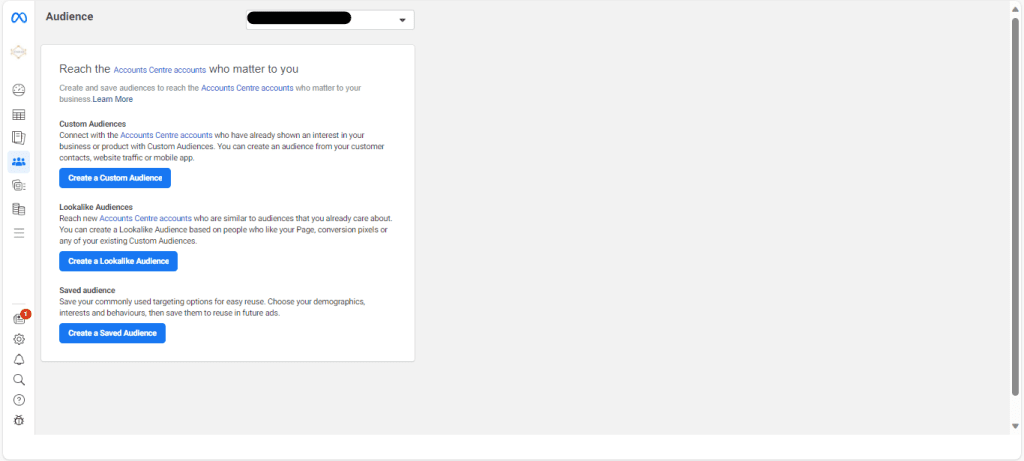
Wow, amazing blog format! How lengthy have you been running a blog for?
you make blogging look easy. The full look of your site
is great, as well as the content! You can see similar here
e-commerce